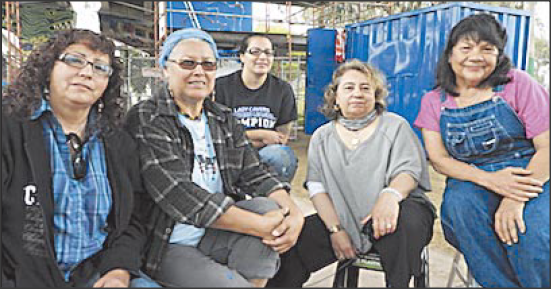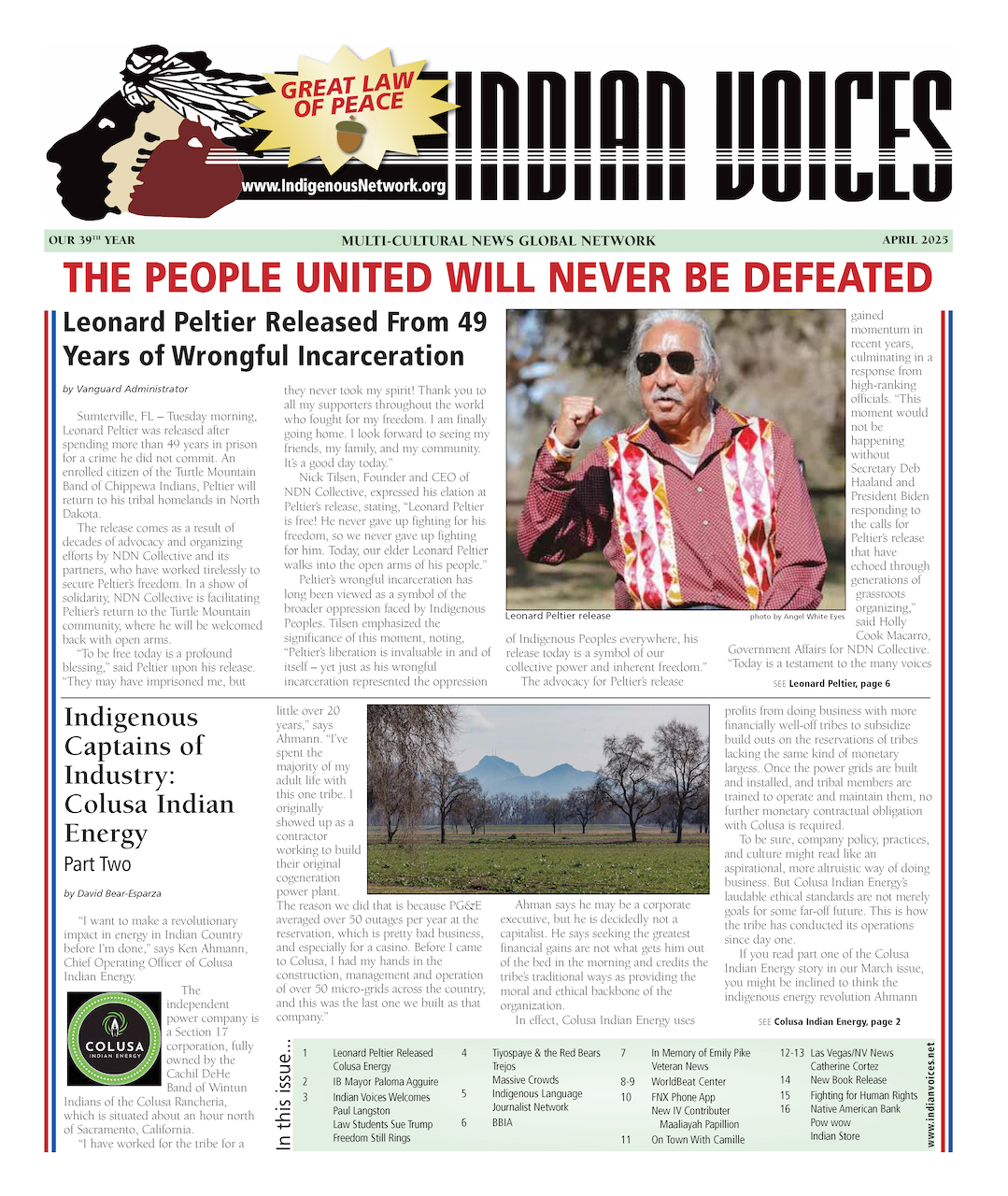By: Gail Perez
SAN DIEGO, CA - “Being the disobedient woman was the only way to save your soul,” Irma Lerma Barbosa exclaims when she recalls growing up Chicana/Yaqui in Sacramento and then navigating the heady days of the Chicano Movement. She, along with Celia Herrera Rodriguez and Rosalinda Montez Palacios, returned in early July to restore their Women Hold Up Half the Sky mural as part of the historic Chicano Park Restoration Project. Missing from the original team are Antonia Perez and Barbara Desmangles. San Diego artists Glory Galindo Sanchez and Vera Sanchez, however, now complete the current team. Both were responsible for preparing the wall and other essential tasks.
Over the past year, restoration artists who originally painted their murals in the 1970s have been present at the park not only repainting, but also teaching about a time when many were deeply involved in the United Farm Workers Movement, in community organizing, in the Chicano Moratorium against the war in Vietnam, and in the struggle for a decolonized identity.
Now, these women artists teach us how young women at the time struggled not only as members of such movements, but also as advocates against sexism within those movements. The three returning women have remained active as artists/organizers to this day. They remind us that it is simply impossible to appreciate the early murals without understanding that they are the work of young people who were embedded in the many strands of the civil rights and radical movements of the time, with all of their contradictions. Barbosa, Rodriguez, and Palacios are three “disobedient” women who sought to portray the Chicano Movement through the “different lens” of their Chicana experiences.
Celia Herrera Rodriguez, now a professor at UC Berkeley, recalls that from the beginning the mural was immediately embroiled in controversy. The women were associated with the Royal Chicano Air Force (RCAF), a legendary group that completed three murals in the park. In Marilyn Mulford’s 1988 documentary Chicano Park the RCAF’s José Montoya, assuming the speech of an Air Force commander, declared: “The women jumped the gun” by arriving earlier than expected and “it was a solo flight” that is usually a “court martial. Again, it is the old machismo coming out. But they did a very beautiful pillar.”
Rodriguez remembers the court martial as “traumatic,” and explains from her perspective how the mural came to be. In 1975, San Diego artist Antonia Pérez told her that there were no women painting in Chicano Park and wondered if she knew that the RCAF was painting a mural. While the RCAF felt that the women took one of their walls, Rodriguez says,” Antonia Perez recently told me that the wall was given to us women. I did what Antonia asked me and went to Sacramento to look for women artists.” There she recruited Barbosa and Palacios among others. When it reached the leadership of the RCAF that the women were going to paint a wall they viewed as theirs, Celia simply responded, “We need to do this.”
The stand the women took must be understood within the context of the change in gender consciousness at the time. Rodriguez attended the 1975 World Conference on Women convened by the United Nations. The point of the conference was to discard notions of merely supporting women and to focus on the agency of women in developing within their own nations and in fighting discrimination. In addition, all three women went to Cuba on the Venceremos Brigade. “Going to Cuba was a miracle,” Rod-riguez explains. “I didn’t know what it meant, but I knew it meant an open door.” Rodriguez went on to work with CASA (Center of Autonomous Social Action) and Bert Corona and for the past ten years has been a member of the UN Permanent Forum on Indigenous Issues. Irma Yerma Barbosa was a member of the RCAF, an original member of the Sacramento Brown Berets, and after the controversy with RCAF went on to found the Com-adres Artistas, an all women’s group. Rosalinda Palacios is a sixth generation Californian (“ we were here before there was a border”) and has a long history of involvement with progressive movements, including her work with the Chicano Moratorium in 1970 and organizing with the United Farm Workers Movement. All three emphasize that they never thought of themselves as just artists. As Palacios says, “The term artist was not in our vocabulary. We did it all.” She recalls creating posters and fliers and putting them on Greyhound buses to publicize events like the Chicano Moratorium.
The conception of the mural began in a discussion around Rodriguez’s kitchen table in Sacramento. Palacios says, “We wanted to do something about consciousness and women’s part in the revolution and movement” and “not the usual stuff.” Rodriguez emphasizes that the title has always been Women Hold Up Half the Sky, a Confucian proverb taken up by Mao Tsetung. This explains the indigenous women on the top of the mural who hold up the sky/pylon.
When asked about the iconography of the mural, the artists insist that everything — activism, family, indigenous and female consciousness — contributed to the mural, especially, a new awareness of the female body that was blossoming in the 70’s. As with any monumental art, male and female figures are central, from Michelangelo’s Sistine Chapel to Chicano Park’s Aztec warriors and Mujer Cosmica. The figures in Women Hold up Half the Sky, though, have received negative attention. “You better put some chonies (panties) on that girl,” one male artist recently said referring to one of the painting’s female figures.
Palacios explains how such attitudes continue to be hurtful. At Chicano Park, male artists have represented the nude female body but not like women artists: “Coming here, we put up women in a natural position. We all come to this place with a different consciousness. Men develop their consciousness in a different way. But the point is that our ways were not accepted.” She emphasizes that her “brother artists” are allowed their perspective, but the women’s lens was not allowed. Since the 70’s were a time when women were reinterpreting their bodies in non-sexist and non-shame based ways, this silencing and continuing ridicule hurts.
All three women emphasize how gender balance is central to the indigenous culture so richly celebrated in the park. Palacios’s studies in Mexico taught her the concept of La Dualidad (duality): “We on the planet are equal to the stars, the tress, fish, water. We have that equality. Without duality, there can be no existence.” When women are removed from a central position, the whole premise of cosmic balance is violated. ng. This is a crucial distinction they make about the roles of women as viewed by their antagonists: “We are not supposed to tell the truth. We’resupposed to be quiet,” Barbosa states.
The restoration/revitalization work of Rodriguez, Barbosa, and Palacios along with Sanchez and Sanchez, prevails against the erasures of the past. Women Hold Up Half of the Sky invites us to contemplate how women who refuse to be devalued continue to struggle and resist the ecological, political and psychological assaults on all of us. Our very continued existence relies on restoring the feminine and making visible the women who really do hold up half the sky and half of Chicano Park.
Gail Pérez is a professor in the ethnic studies department at the University of San Diego.



